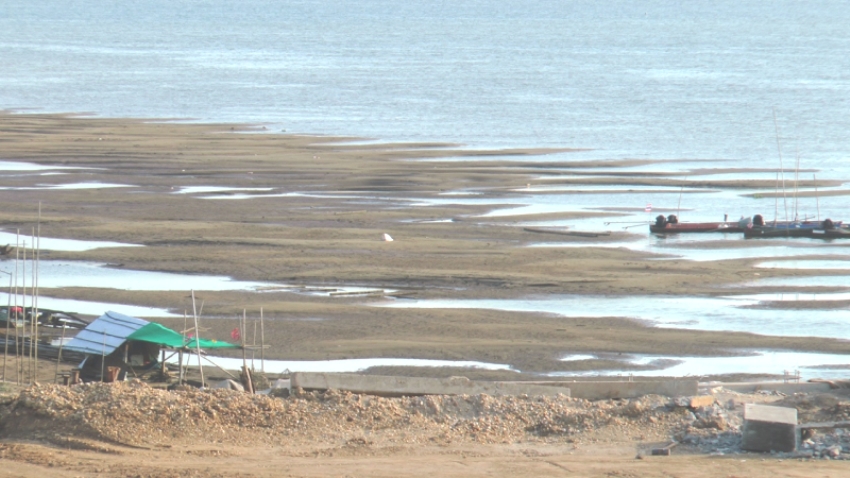News
China Dams Continue to Hinder Water Flow on the Mekong River

China’s water relations with Thailand and the other lower Mekong countries are once again under strain after Beijing held up the Mekong River’s flow at one of its large dams upstream, precipitating a sudden drop in volume for downstream countries that share the region’s longest body of water.
“The water levels dropped suddenly since the beginning of January,” fumed Niwat Roikaew, chairperson of Love Chiang Khong Group, a nonprofit environmental campaign in Chiang Rai, a northern Thai province where the Mekong flows past. “We all know this happened because China closed the dam.”
An estimated 60 million people along the lower Mekong depend on the river’s flow for their livelihood. Communities in Thailand, Cambodia, Laos and Vietnam were caught off guard by Beijing’s move, worsening their plight in the midst of the annual dry season.
By mid-February there was little relief in river basin communities affected by China’s decision to reduce the discharge from Jinghong Dam in Yunnan Province. China’s Ministry of Water Resources informed the lower Mekong countries of its tests at the mega-dam in early January, almost a week after it began to slash the flow to 1,000 cu. meters per second from the usual 1,900 cu. meters. The tests were to have been completed by Jan. 24.
The fluctuating river flow has fallen to “worrying levels,” the Mekong River Commission said in a report this month. The intergovernmental body — representing Cambodia, Laos, Thailand and Vietnam — manages the Mekong basin’s ecology.
“There have been sudden rises and falls in water levels immediately downstream of Jinghong and further down to Vientiane [the Laotian capital], which has been challenging for authorities and communities to prepare for and respond to possible impacts,” an MRC official said in the report.
Lack of cooperation from China
The MRC’s warning highlights a diplomatic shortcoming that continues to dog China and its southern riparian countries: a lack of cooperation over a shared natural resource.
“There is still a need to deepen cooperation on transboundary water governance,” said Carl Middleton, director of the Center for Social Development Studies at Chulalongkorn University in Bangkok. “The appropriate goal is [for the] accountable operation of hydropower projects that avoid social and environmental impacts to the extent possible, while acknowledging and compensating for harms created.”
China, which refers to the Mekong as the Lancang River, has been in the crosshairs of local and international environmentalists for the power it wields to reduce the water flow. Critics say Beijing uses the river as a tap to be turned on or off to meet domestic water requirements.
“As an upstream country, it looks at the river as a canal, or as H2O (water), and has the power to determine the river’s use,” said Pianporn Deetes, Thailand campaign director for International Rivers, a global environmental defense group. “But it is not about China alone, because there is a need for governance of the river that recognizes its ecological value and its multiple uses for millions of local communities.”
The tension between Beijing and the Mekong basin communities, sparked by China’s construction of 11 large dams in its upstream stretch of the river, has tested the ties the Asian powerhouse has sought to build with neighbors in mainland Southeast Asia. Vietnam, when it chaired the 10-member Association of Southeast Asian Nations last year, elevated the concerns about the Mekong for the entire bloc to consider.
Rice bowl of the region
The Mekong begins its 4,600 km journey from China’s Tibetan Plateau and snakes south through Yunnan Province, flowing past Myanmar into the Mekong basin through Vietnam’s Mekong Delta until it empties into the South China Sea. The basin is the rice bowl of the region.
A severe drought in 2019 laid bare the impact that dams in China and in other Mekong countries like Laos have on the river communities. Affected were the rice fields in Vietnam’s Mekong Delta as well as Cambodia’s Tonle Sap, a giant lake that needs the Mekong’s waters for its abundant supply of fish — a staple in the local diet.
“The Vietnamese and the [Cambodians] in the lower Mekong have evolved agricultural systems [and systems for riverine fisheries] that are closely attuned to the river’s rise and fall,” David Brown, a former Vietnamese-based U.S. diplomat, told Nikkei Asia. “Now, the productivity of both agriculture and fisheries is impacted by climate change, China’s Lancang dams and the damming of Mekong tributaries in Laos and, to a lesser extent, in Vietnam’s central highlands.”
China’s plans to share data
China’s efforts to mitigate the damage have been measured by its willingness to share river flow data with the lower Mekong countries. Until last year, China shared its water flow information only during the annual wet season from June through October, when the river and its tributaries swell and contribute to the annual floods that farmers depend on.
Following the 2019 drought, China relented to calls from southern neighbors for water flow data covering the dry season. Premier Li Keqiang in August revealed China’s plans to share data during the dry season at a summit of the riverine countries that are members of the Lancang-Mekong Cooperation initiative, a Beijing-created body that includes the MRC members, Myanmar and China.
But local community leaders like Niwat, in Thailand, remain unimpressed.
“We as a Mekong community need to discuss and come up with an agreement of how much water must be released [from Chinese dams] each time to keep the natural cycle for many lives along the river,” he said. “China cannot make this decision alone.”
Source: Nikkei






























